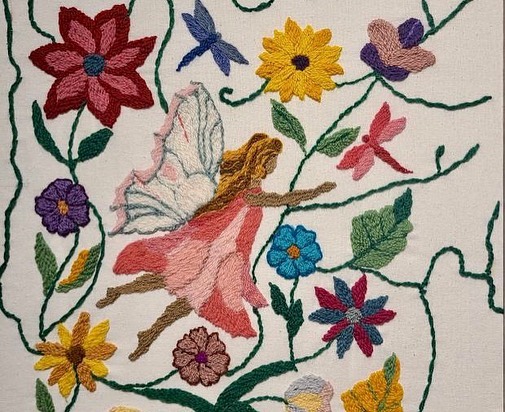Origins of the art form are uncertain. One theory links colcha to the Far East and a form of Chinese silk embroidery. That could explain its genesis. But another and far more practical explanation of its roots is as close, geographically, to Mexico, or that part of Mexico that we know today as New Mexico.

Colcha is a unique type of embroidery that dates back to the early 18th century in what is now New Mexico and the Spanish Colonial period. It also appeared during the same period in what today is the San Luis Valley.
The word colcha refers to tightly embroidered coverlets or bed coverings. Today colcha simply means a type of stitch for not only bed covers but small pillows, cushions, shawls or anything that creative, artistic stitching can be adorned with.
“Colcha is beautiful because it involves the area and history,” said Connie Fernandez, who is part of a Taos, New Mexico, group of women who meet monthly. While some of what is created by members of this group is amazing, Fernandez, said by any number of names, including bokhara couching, convent, Deerfield and figure stitch.
Some of the oldest examples of colcha, said the Taos resident, is linked to the sheep that Spanish settlers brought to the region. Churro is the breed that provided the wool for the delicate colcha artwork. It would be carded and dyed with a variety of native plants to provide the hues for the purples, greens, yellows and browns that are featured in so many of the pieces.
From its earliest days in the region to today, the women—it is mostly women—who create this intricate artwork are limited only by imagination. The yarn is magically mated with the fabric to create religious themes, landscapes, old Taos, San Luis or the many towns and villages that many of the dordadoras or embroiderers come from.
“I’m in awe of some of my contemporaries,” said Fernandez. When they gather, usually monthly at the Taos Hacienda, their time is divided between visiting, sharing new ideas for future works or learning something new about this generational art form. “We teach each other,” said Fernandez. “We encourage,
inspire, share ideas and have fun…it is not something like a class you have to attend. We help each other with the main purpose—besides preserving a cultural tradition—to put on exhibits and demonstrations.”
Working with her hands, said Fernandez, sewing, knitting and embroidery, has been a part of her life since her earliest years in her home state of Connecticut. “Both of my grandmothers loved needle work and my fraternal grandmother would embroider,” she said. Her fraternal grandmother, she remembered, “worked in a sewing factory, sewing handkerchiefs.” Her own mother, however, “did not like sewing—not even a button.”
Colcha, said Fernandez, does not require a major investment for those who might want to learn this art form. Almost any fabric store will have a basic embroidery kit, she said, that will get you started.
The upcoming “Colcha Embroidery: Traditional & Contemporary” Exhibit will be held at La Hacienda de Los Martinez in Taos from July 1 to July 31, 2023.



